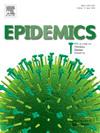蓖麻蜱种群动态的环境驱动因素:利用纵向野外调查和气候数据的机制建模
IF 2.4
3区 医学
Q2 INFECTIOUS DISEASES
引用次数: 0
摘要
在整个欧洲,蓖麻伊蚊是莱姆病和蜱传脑炎的主要媒介。然而,蜱虫复杂生命周期的环境驱动因素尚未用现实世界的数据量化,这使得将蜱虫人口统计学纳入蜱媒疾病传播模型具有挑战性。为了解决这一差距,我们将一个机制模型拟合到法国北部四个地点的详细的10年纵向数据集,在那里蓖麻I. ricinus丰富,莱姆病和蜱传脑炎已经报道了几十年。通过结合关键的人口统计过程和环境条件对这些过程的影响,我们的模型估计了在温度或饱和缺陷范围内的产卵、孵化和换毛率,以及探索和脊椎动物宿主接触率。人口研究的蜱虫,蜕皮 达到峰值14.2°C(-16.1 95 %人类发展指数:12.5 °C),大大低于一般建议的实验室研究,而产卵和孵化 达到峰值24.4°C(-27.2 95 %人类发展指数:10.9 °C)和24.7 °C(95 %人类发展指数:17.8 - -27.2 °C),分别。此外,四个研究地点的经验基线脊椎动物宿主接触率参数差异显著,其中一个地点的接触率比其他三个地点高2.90倍(95 %HDI: 2.15-3.86)。此外,对于通过滞育越冬的蜱虫来说,与夏季的换羽相比,春季的换羽更准确地匹配了观察到的主要单峰寻巢模式。在悲观气候变化情景下,蜱虫丰度呈下降趋势,而在温和气候变化情景下,蜱虫丰度没有显著下降。本研究为建立蓖麻伊蚊病原传播模型奠定了基础,并可适用于其他具有公共卫生意义的伊蚊种群。本文章由计算机程序翻译,如有差异,请以英文原文为准。
Environmental drivers of Ixodes ricinus tick population dynamics: Mechanistic modelling using longitudinal field surveys and climate data
Ixodes ricinus is the primary vector for Lyme disease and tick-borne encephalitis across Europe. However, the environmental drivers of the tick's complex life cycle have not been quantified with real-world data, making it challenging to incorporate tick demography into tick-borne disease transmission models. To address this gap, we fitted a mechanistic model to a detailed 10-year longitudinal dataset from four sites in Northern France, where I. ricinus is abundant and Lyme disease and tick-borne encephalitis have been reported for decades. By incorporating key demographic processes and the influence of environmental conditions on these processes, our model estimated oviposition, hatching, and moulting rates across a range of temperature or saturation deficit, as well as questing and vertebrate host contact rates. In the studied tick population, moulting peaked at 14.2 °C (95 %HDI: 12.5–16.1 °C), substantially lower than commonly suggested by laboratory-based studies, whereas oviposition and hatching peaked at 24.4 °C (95 %HDI: 10.9–27.2 °C) and 24.7 °C (95 %HDI: 17.8–27.2 °C), respectively. Furthermore, the parameter scaling the empirical baseline vertebrate host contact rates was found to vary significantly between the four study sites, with one site presenting up to 2.90 (95 %HDI: 2.15–3.86) times higher contact rates than the other three sites. Additionally, for ticks overwintering through diapause, moulting in spring more accurately matched the predominantly unimodal questing patterns observed, compared to moulting in summer. Finally, model projections under pessimistic climate change scenarios indicated decreasing tick abundance trends over the next two decades, while no significant decrease was predicted under moderate scenarios. This study provides a foundation for models of I. ricinus-borne pathogen transmission and can be adapted to other Ixodidae populations of public health significance.
求助全文
通过发布文献求助,成功后即可免费获取论文全文。
去求助
来源期刊

Epidemics
INFECTIOUS DISEASES-
CiteScore
6.00
自引率
7.90%
发文量
92
审稿时长
140 days
期刊介绍:
Epidemics publishes papers on infectious disease dynamics in the broadest sense. Its scope covers both within-host dynamics of infectious agents and dynamics at the population level, particularly the interaction between the two. Areas of emphasis include: spread, transmission, persistence, implications and population dynamics of infectious diseases; population and public health as well as policy aspects of control and prevention; dynamics at the individual level; interaction with the environment, ecology and evolution of infectious diseases, as well as population genetics of infectious agents.
 求助内容:
求助内容: 应助结果提醒方式:
应助结果提醒方式:


